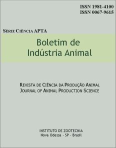Yield and nutitive value of maize hybrids for silage according to distance and density of sowing
Keywords:
digestibility, forage, lignin, maturity, stalk, Zea mays LAbstract
Two corn hybrids of semi flint grains red-orange, BM 2202 and BRS 3003 of precocity cycle and medium/height size, were used to evaluate the yield and nutritive value of silageaccording to distance and density of sowing. The experimental design was the randomized complete factorial model, were used two hybrids (BM 2202 and BRS 3003), two spacing (0.45 and 0.90m), three densities (60,000; 70,000 and 80,000 plants per ha) with three replications. The characters studied were: dry matter contents (DM), plant fractions proportions, dry matter yield (t ha-1), stalk bromatology components correlated with neutral detergent fiber (NDF), fiber in acid detergent (ADF), hemicellulose, cellulose, lignin and in vitro digestibility of dry mater (IVDMD). The DM percentage of the whole plant to hybrid BM 2202 (49.50%) was higher in comparison to BRS 3003 hybrid (44.97%), also to distance with 49,03% (0,90 m) and 45.44% (0.45m) without density effect. Kernel contribution was higher in BM 2202 hybrid (50.20%) and for the distance the variable stalk percentage had 24.01% (0.45m) and 21.21% (0.90m) of contribution. The BRS 3003 hybrid showed better yield in whole plant to DM (t ha-1), including the fractions. In general BRS 3003 hybrid showed low fiber concentration and bigger IVDMD. The reduction of the spacing from 0.90 to 0.45 m generated biggest production of DM and better nutritive value characteristics for silage with low concentrations of NDF, ADF, hemicelulose, cellulose and lignin of stalk due to failure intra-specific competition between plants. The density did not demonstrate differences in the gains of DM and NDF, ADF cellulose and lignin concentrations, being smaller at density of 60,000pl ha-1. We concluded that the low spacing (0.45m) and densities 60,000 and 70,000pl ha-1, gives forage with better nutritive value to maize silage.
Downloads
Downloads
Published
Issue
Section
License
Os autores não serão remunerados pela publicação de trabalhos, pois devem abrir mão de seus direitos autorais em favor deste periódico. Por outro lado, os autores ficam autorizados a publicar seus artigos, simultaneamente, em repositórios da instituição de sua origem, desde que citada a fonte da publicação original seja Boletim de Indústria Animal. A revista se reserva o direito de efetuar, nos originais, alterações de ordem normativa, ortográfica e gramatical, com vistas a manter o padrão culto da língua e a credibilidade do veículo. Respeitará, no entanto, o estilo de escrever dos autores. Alterações, correções ou sugestões de ordem conceitual serão encaminhadas aos autores, quando necessário. Nesses casos, os artigos, depois de adequados, deverão ser submetidos a nova apreciação. As opiniões emitidas pelos autores dos artigos são de sua exclusiva responsabilidade. Todo o conteúdo deste periódico, exceto onde está identificado, está licenciado sob a Licença Creative Commons Attribution (CC-BY-NC). A condição BY implica que os licenciados podem copiar, distribuir, exibir e executar a obra e fazer trabalhos derivados com base em que só se dão o autor ou licenciante os créditos na forma especificada por estes. A cláusula NC significa que os licenciados podem copiar, distribuir, exibir e executar a obra e fazer trabalhos derivados com base apenas para fins não comerciais.













